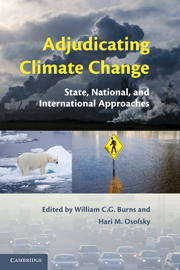Book contents
- Frontmatter
- Contents
- Foreword
- Acknowledgments
- Adjudicating Climate Change
- 1 Overview: The Exigencies That Drive Potential Causes of Action for Climate Change
- PART I SUBNATIONAL CASE STUDIES
- PART II NATIONAL CASE STUDIES
- PART III SUPRANATIONAL CASE STUDIES
- 17 Conclusion: Adjudicating Climate Change across Scales
- Index
- References
17 - Conclusion: Adjudicating Climate Change across Scales
Published online by Cambridge University Press: 25 August 2009
- Frontmatter
- Contents
- Foreword
- Acknowledgments
- Adjudicating Climate Change
- 1 Overview: The Exigencies That Drive Potential Causes of Action for Climate Change
- PART I SUBNATIONAL CASE STUDIES
- PART II NATIONAL CASE STUDIES
- PART III SUPRANATIONAL CASE STUDIES
- 17 Conclusion: Adjudicating Climate Change across Scales
- Index
- References
Summary
INTRODUCTION
This book explores climate change litigation in its many existing and potential variations. As this volume was being written, the number of relevant cases and their impact increased dramatically. Most notably, the U.S. Supreme Court's decision in Massachusetts v. EPA – together with a cultural shift symbolized by Al Gore and the Intergovernmental Panel on Climate Change (IPCC) winning the Nobel Peace Prize – transformed the policy and litigation landscape. The election of President Obama changed things further, with his commitment to active U.S. participation in international climate treaty negotiations and to a robust federal regulatory approach to greenhouse gas emissions.
The concluding chapter grapples with how this evolution impacts the way in which we should view the role of litigation as part of transnational regulation of climate change. Although we are still early in this story that Peter Roderick's foreword began, some of the impacts of climate change litigation are already clear. David Hunter's chapter, The Implications of Climate Change Litigation: Litigation for International Environmental Law-Making, does an excellent job of analyzing these cases as vehicles for promoting greater public awareness. This chapter builds upon his analysis by focusing back on the issues of scale raised in the Introduction.
As a scientific and legal matter, climate change is multiscalar. In other words, emissions, impacts, and the legal structures that interact with them are simultaneously individual, local, state, national, international, and every level in between.
- Type
- Chapter
- Information
- Adjudicating Climate ChangeState, National, and International Approaches, pp. 375 - 386Publisher: Cambridge University PressPrint publication year: 2009
References
- 3
- Cited by

